Khurana Hershey's Research Lab
Dr. Khurana Hershey’s research focuses on the overall goal of improving the health of children with asthma. Her laboratory integrates clinical, epidemiologic, translational, and basic research approaches in order to identify and delineate the mechanistic basis of genetic and environmental factors that contribute to the development, progression, and persistence of asthma. Current projects in the laboratory include:
(1) Mechanisms of the atopic march and the development of allergic disease co-morbidity.
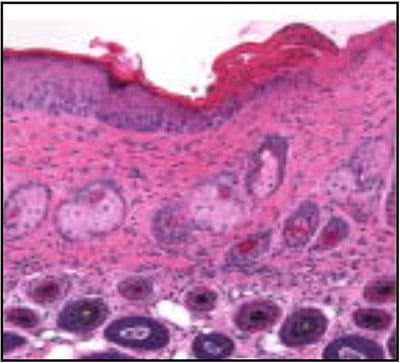 Elucidating the cellular and molecular mechanisms that promote the development and persistence, remission, and / or resolution of allergic inflammation and asthma using integrated approaches including human based studies, multi-omics approaches, in vivo mouse models and in vitro models of allergen exposure, asthma, food allergy, and atopic dermatitis. These findings have identified and elucidated the role of biologic pathways and identified new targets for therapeutic intervention. They have also helped to define the signaling and regulatory networks that impact these pathways.
Elucidating the cellular and molecular mechanisms that promote the development and persistence, remission, and / or resolution of allergic inflammation and asthma using integrated approaches including human based studies, multi-omics approaches, in vivo mouse models and in vitro models of allergen exposure, asthma, food allergy, and atopic dermatitis. These findings have identified and elucidated the role of biologic pathways and identified new targets for therapeutic intervention. They have also helped to define the signaling and regulatory networks that impact these pathways.
(2) Environmental Factors and Mechanisms of Allergic Diseases
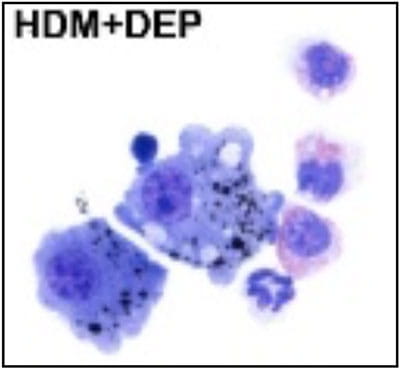 Delineating the environmental factors that promote the development and persistence of asthma and other allergic disorders, and elucidation of the mechanistic basis for their contributions. The central goal of these studies is to better understand how environmental factors including allergens contribute to asthma and other allergic diseases, design biomarkers to identify vulnerable exposed populations, and design prevention and intervention strategies targeted to these exposed groups. Specifically notable contributions are that mold and traffic pollution, common asthma promoting environmental exposures whose mechanisms were previously unknown, contribute to severe asthma by promoting Th17 responses, and neutralization of IL-17A counteracts the asthma-promoting effects of mold and traffic pollution. These findings directly implicate new personalized human translational interventions that are currently underway.
Delineating the environmental factors that promote the development and persistence of asthma and other allergic disorders, and elucidation of the mechanistic basis for their contributions. The central goal of these studies is to better understand how environmental factors including allergens contribute to asthma and other allergic diseases, design biomarkers to identify vulnerable exposed populations, and design prevention and intervention strategies targeted to these exposed groups. Specifically notable contributions are that mold and traffic pollution, common asthma promoting environmental exposures whose mechanisms were previously unknown, contribute to severe asthma by promoting Th17 responses, and neutralization of IL-17A counteracts the asthma-promoting effects of mold and traffic pollution. These findings directly implicate new personalized human translational interventions that are currently underway.
(3) Skin Microbiome and Pathogenesis of Atopic Dermatitis and Atopic Disease Progression
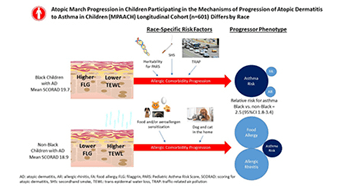 Delineating the skin microbiome that promote the development, persistence, and progression of atopic dermatitis, and elucidation of the mechanistic bases for their contributions. The central goal of these studies is to delineate the skin colonizing microbes that colonize the skin of children with atopic dermatitis and determine the microbial and host factors that contribute to pathologic colonization, as well as the mechanisms underlying these contributions. We aim to develop biomarkers and novel therapies to aid in prevention, management, and treatment of atopic dermatitis and allergic disease.
Delineating the skin microbiome that promote the development, persistence, and progression of atopic dermatitis, and elucidation of the mechanistic bases for their contributions. The central goal of these studies is to delineate the skin colonizing microbes that colonize the skin of children with atopic dermatitis and determine the microbial and host factors that contribute to pathologic colonization, as well as the mechanisms underlying these contributions. We aim to develop biomarkers and novel therapies to aid in prevention, management, and treatment of atopic dermatitis and allergic disease.
(4) Understanding Asthma Heterogeneity
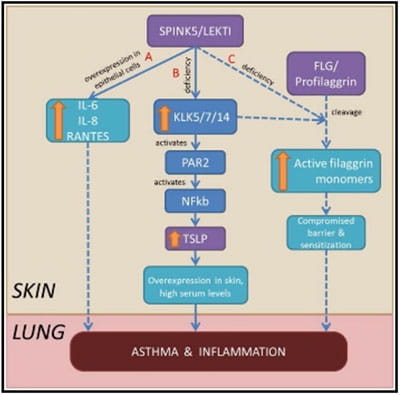 Molecular endotyping of asthma and other allergic diseases to better understand disease pathogenesis and identify clinically relevant disease endotypes, including treatment response. The central goal of these studies is to generate, improve, and test new personalized strategies for prevention, diagnosis, management, and treatment of asthma and allergic disorders. Specifically notable contributions in this area include a current grant focused on elucidating the mechanistic underpinnings of the frequent exacerbator asthma phenotype. We are utilizing multi-omics approaches and leveraging the innovative Ohio Pediatric Asthma Repository to address this knowledge gap. In addition, we recently identified a biological basis for poor steroid response in asthma, which we are now translating to clinical practice. The objective is to improve asthma control among children with severe asthma by identifying children who have a biologic basis for poor treatment response and elucidating novel treatment strategies for these patients. We recently reported that vanin-1 (VNN1) gene expression and promoter methylation in nasal epithelial cells of children hospitalized for acute asthma distinguished good and poor treatment responders. Further, VNN1-/- mice developed asthma, which was indistinguishable from wild type mice, however VNN1-/- mice were less responsive to dexamethasone treatment. Collectively, these data demonstrate that VNN1 contributes to optimal steroid response in asthma. Targeting this pathway improves treatment response to steroids. These studies are potentially very high impact because one drug targeting this pathway, cysteamine, has already been FDA-approved since 1994 for treatment of cystinosis. It has a known safety profile with long-term use in children who now have taken the drug for two decades.
Molecular endotyping of asthma and other allergic diseases to better understand disease pathogenesis and identify clinically relevant disease endotypes, including treatment response. The central goal of these studies is to generate, improve, and test new personalized strategies for prevention, diagnosis, management, and treatment of asthma and allergic disorders. Specifically notable contributions in this area include a current grant focused on elucidating the mechanistic underpinnings of the frequent exacerbator asthma phenotype. We are utilizing multi-omics approaches and leveraging the innovative Ohio Pediatric Asthma Repository to address this knowledge gap. In addition, we recently identified a biological basis for poor steroid response in asthma, which we are now translating to clinical practice. The objective is to improve asthma control among children with severe asthma by identifying children who have a biologic basis for poor treatment response and elucidating novel treatment strategies for these patients. We recently reported that vanin-1 (VNN1) gene expression and promoter methylation in nasal epithelial cells of children hospitalized for acute asthma distinguished good and poor treatment responders. Further, VNN1-/- mice developed asthma, which was indistinguishable from wild type mice, however VNN1-/- mice were less responsive to dexamethasone treatment. Collectively, these data demonstrate that VNN1 contributes to optimal steroid response in asthma. Targeting this pathway improves treatment response to steroids. These studies are potentially very high impact because one drug targeting this pathway, cysteamine, has already been FDA-approved since 1994 for treatment of cystinosis. It has a known safety profile with long-term use in children who now have taken the drug for two decades.
(5) Innovative Cohorts and Epidemiology of childhood asthma and other allergic disorders
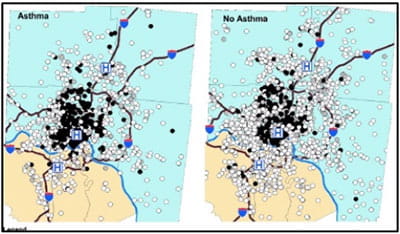 Dr. Khurana Hershey’s team has built and contributed to several innovative longitudinal cohorts over the last 2 decades to study the epidemiology of childhood asthma and allergic disease and conduct outcomes studies in childhood asthma. These cohorts include the Greater Cincinnati Pediatric Clinic Repository (GCPCR), the Mechanisms of Progression of Atopic Dermatitis to Asthma in Children, the first early life cohort of children with eczema in the U.S., the Ohio Pediatric Asthma Repository (OPAR), of the first state-wide repository for asthma, and the Cincinnati Childhood Asthma and Air Pollution Study (CCAAPS) birth cohort. These cohorts have resulted in numerous publications and critical new insights into the epidemiology of disease, phenotypes of childhood asthma, identification of genetic and environmental factors that promote development and persistence of asthma and allergic diseases. The cohorts provide a tremendous and unique infrastructure for translation of findings from epidemiologic studies to the laboratory and back to human patients
Dr. Khurana Hershey’s team has built and contributed to several innovative longitudinal cohorts over the last 2 decades to study the epidemiology of childhood asthma and allergic disease and conduct outcomes studies in childhood asthma. These cohorts include the Greater Cincinnati Pediatric Clinic Repository (GCPCR), the Mechanisms of Progression of Atopic Dermatitis to Asthma in Children, the first early life cohort of children with eczema in the U.S., the Ohio Pediatric Asthma Repository (OPAR), of the first state-wide repository for asthma, and the Cincinnati Childhood Asthma and Air Pollution Study (CCAAPS) birth cohort. These cohorts have resulted in numerous publications and critical new insights into the epidemiology of disease, phenotypes of childhood asthma, identification of genetic and environmental factors that promote development and persistence of asthma and allergic diseases. The cohorts provide a tremendous and unique infrastructure for translation of findings from epidemiologic studies to the laboratory and back to human patients
(6) Asthma in Urban Environments
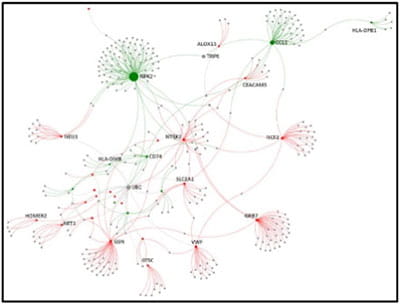 Dr. Khurana Hershey is the PI for the Cincinnati site of the NIAID-funded Inner City Asthma Consortium study, which is focused on understanding the factors that promote asthma in the inner city environment and identifying the best management and treatment strategies for this vulnerable population.
Dr. Khurana Hershey is the PI for the Cincinnati site of the NIAID-funded Inner City Asthma Consortium study, which is focused on understanding the factors that promote asthma in the inner city environment and identifying the best management and treatment strategies for this vulnerable population.
Research Program
The Khurana Hershey Lab offers a variety of different educational opportunities for ambitious, self-motivated individuals. Our lab is dedicated to providing goal-driven individuals with outstanding educational knowledge and leadership skills to be successful and competitive in any type of environment. The Khurana Hershey Lab is interested in offering opportunities to post-doctoral and clinical fellows, graduate students as well as volunteer, co-op and summer research opportunities to undergraduates. Click here to learn more about open opportunities in the Khurana Hershey lab.












